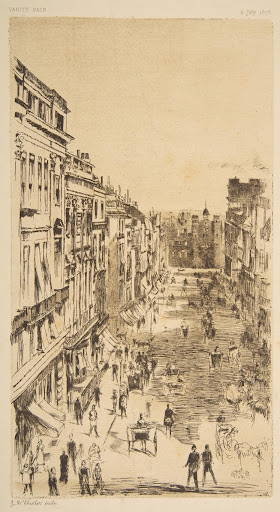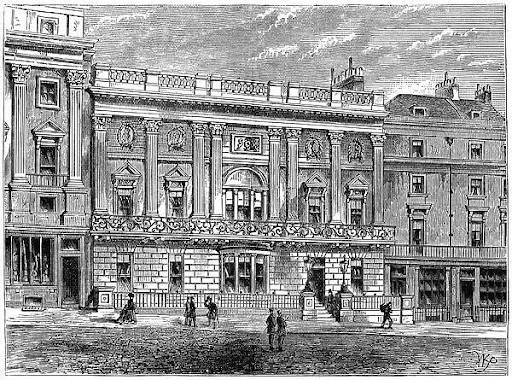Adelaide Magnolia Letter 11 – St. James Street
St. James Street and White’s

St. James Street. James McNeill Whistler 1878. Courtesy of Metropolitan Museum of Art.
St. James Street is a well known street located in central London. It runs between Piccadilly and St. James Palace, one of the Royal palaces. St. James Street was famously the heart of fashionable London for the men in the ton. This is where they would keep their rooms, their mistresses, and buy their clothing. It was also the location for the most popular of the Gentlemen’s clubs of the day. These clubs were members-only establishments and membership was exclusive and limited to men in the upper echelons of society. The establishments offered its members a place to take meals, have a drink, read in the library, and gamble.
Today, St. James’s is still referred to as “clubland” as there are still many members-only clubs running there today.

White’s in Old and New London: Volume 4 by Edward Walford (London, 1878). British History Online [accessed 20 February 2023].
White’s opened its doors in 1778 on St. James St.. It is the oldest and most exclusive gentleman's club in the world. White’s was a place where gentlemen of the aristocracy and upper classes gathered to socialize and discuss politics. The club was so popular that in the late 18th century, membership had to be limited due to overcrowding. It also played an important role in London's social scene, as it often hosted balls and other social gatherings.
White's was most known for its extravagant gambling, and many members of the ton spent large amounts of money there. Much of the gambling was played at cards, but any of White’s members could bet or wager on anything at any time, as long as it was written down in the club’s infamous betting book. The bets in the book were available for all to look at and gossip about. The loser was required to pay the winner promptly or their membership at White’s would be revoked. Most of the bets were made on significant events happening at the time, but some were extremely silly and trivial. There were bets made about the defeat of Napoleon, on marriages, and children, and even on things such as which raindrop would reach the bottom of a windowpane first!
White’s has a long and illustrious history and has been frequented by many of the most powerful and influential figures in British history. The Prince of Wales, Charles II, George II, George III, and the Duke of Wellington all held memberships there during their lives. Over the centuries, White’s has been renowned for its extravagant dinners and gambling parties. It’s reputation as a playground for the rich and famous has only grown over time.
Learn the Vernacular:
Churlish prig: someone who is sullen or irritable.
Holly and ivy: common evergreens displayed in homes during Christmas; holly was thought to be masculine, while ivy to be feminine, giving stability to the home. “The Holly and the Ivy” is also the title for a well-known English Christmas song.
Yule Log: a large log brought into the home on Christmas Eve and burned for the 12 days of Christmas until the Epiphany on January 6th. It is to represent the sun during the short days of winter solstice.
Sources:
https://londonhistorians.wordpress.com/2014/06/05/gambling-in-londons-most-ruinous-gentlemens-clubs/
https://nineteenteen.blogspot.com/2011/01/where-boys-are-betting-at-whites.html
https://londonist.com/london/drink/the-curious-world-of-london-s-gentlemen-s-clubs
https://en.wikipedia.org/wiki/White%27s
https://janeaustenslondon.com/2013/05/06/henry-at-whites-oh-what-a-henry/
https://en.wikipedia.org/wiki/St_James%27s_Street
http://www.thelondonliferpg.com/forums/index.php?/forum/76-st-james-street/
